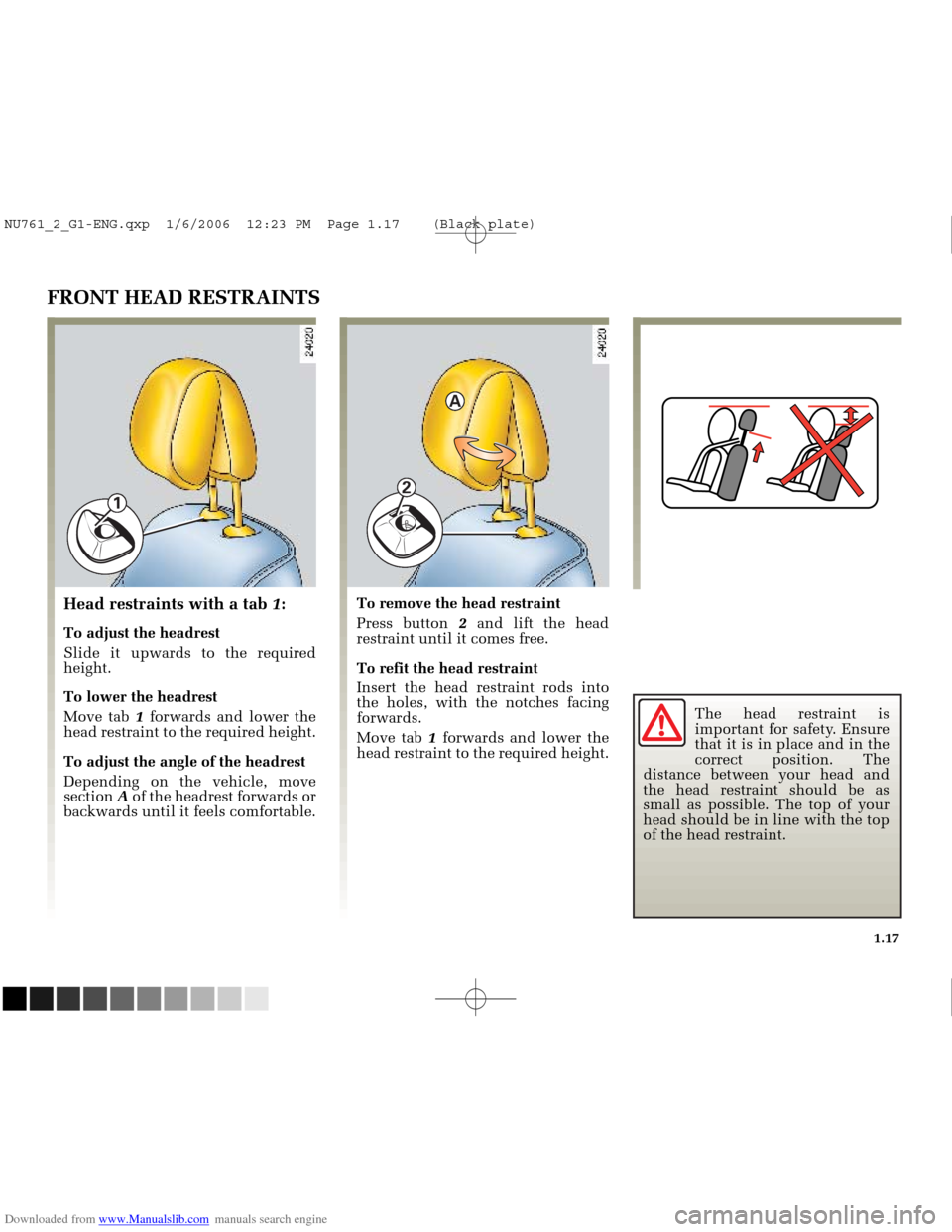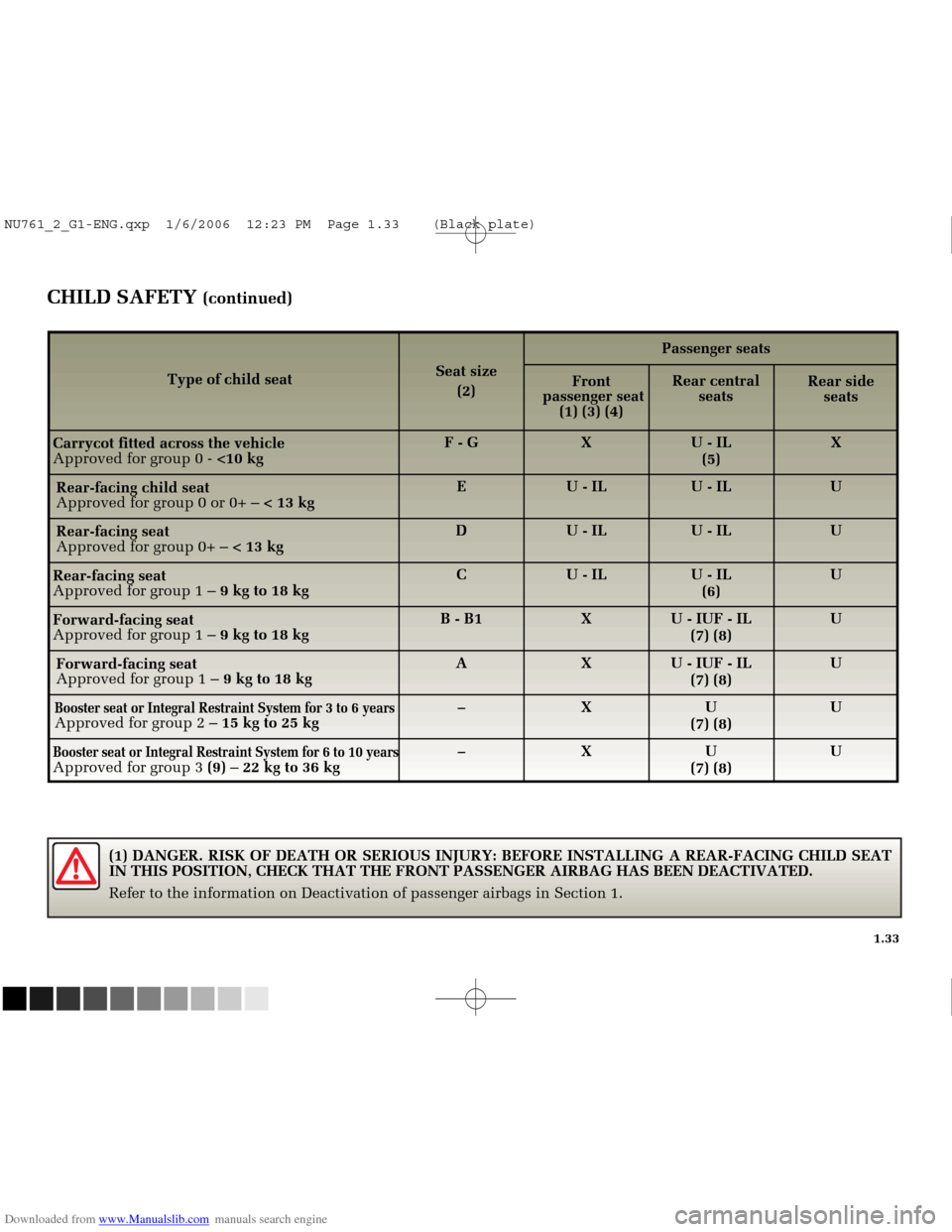Page 15 of 250

Downloaded from www.Manualslib.com manuals search engine
2
1
3
NU761_2_G1-FRA.qxd 10/11/05 15:52 Page 1.05
1.05
Never leave your vehicle
with the RENAULT card
inside.
RENAULT card in hands-free
mode
In addition to the RENAULT card
remote functions, this enables the
following to be carried out without
touching the key card (in hands-free
mode):
- unlocking/locking of the doors andboot and the fuel filler flap if the
card is within access zone 1,
- and starting the engine if the card is present inside the vehicle
passenger compartment (refer to
the information on “Starting the
engine” in section 2).
Unlocking the doors and
luggage compartment
Walk up to your vehicle carrying
your RENAULT card.
As soon as you place your hand
behind the handle of a door 2, the
vehicle will unlock.
When you press button 3, only the
luggage compartment will unlock.
Unlocking is indicated by one flash
of the hazard warning lights and the
side indicator lights.
RENAULT CARD IN HANDS-FREE MODE: use
NU761_2_G1-ENG.qxp 1/6/2006 12:23 PM Page 1.05 (Black plate)
Page 17 of 250

Downloaded from www.Manualslib.com manuals search engine
24088
1
2
NU761_2_G1-FRA.qxd 10/11/05 15:53 Page 1.07
1.07
Never use deadlocking if
someone is still inside the
vehicle.
DEADLOCKING
Deadlocking the doors/luggage
compartment(for some countries)
This allows you to lock the opening
elements (doors, luggage
compartment and, depending on
vehicle, the passenger side storage
compartment) and to prevent the
doors from being unlocked using the
interior handles (for example, by
breaking the window and then
trying to open the door from the
inside).
To activate deadlocking
Vehicles equipped with rear door
electric windows
- press button 1twice in quick
succession.
- or press the exterior door handle buttons or the luggage compartment
badge twice in quick succession.
Vehicles equipped with rear door
manual windows
Before exiting the vehicle, press the
lower section of switch 2(the
integrated indicator lights up). Press
the upper section of the switch to
unlock the doors.
In all situations
The hazard warning lights flash five
times to indicate locking.
Note: it is possible to activate this
function by two simultaneous
presses on the door handle buttons
located on the same side (for
example: front left/rear left orfront
right/rear right).
NU761_2_G1-ENG.qxp 1/6/2006 12:23 PM Page 1.07 (Black plate)
Page 21 of 250

Downloaded from www.Manualslib.com manuals search engine
A
2
1
NU761_2_G1-FRA.qxd 10/11/05 15:53 Page 1.11
1.11
LOCKING/UNLOCKING THE DOORS
Locking/unlocking the doors
from the outside
This is done using the RENAULT
card; see RENAULT card in Section 1.
In certain cases, the RENAULT card
may not work:
- if the vehicle is located in a zone of high electromagnetic radiation,
- if appliances operating on the same frequency as the card (mobile
phone, etc.) are used;
- drain on the RENAULT Card battery, flat battery, etc.
It is then possible:
- to use the emergency key (depending on vehicle, either built
into the card or separate) for the
front left-hand door;
- to manually lock each of the doors (see the following page);
- to use the door locking and unlocking control inside the vehicle
(refer to the information on Locking
and unlocking from the inside in
Section 1).
Using emergency key 2built
into the RENAULT card
Remove cover Afrom the front left-
hand door (using the tip of the
emergency key) in notch 1.
Move it upwards to remove cover A. Insert key
2into the lock of the front
left-hand door and lock or unlock.
NU761_2_G1-ENG.qxp 1/6/2006 12:23 PM Page 1.11 (Black plate)
Page 25 of 250
Downloaded from www.Manualslib.com manuals search engine
1
1
NU761_2_G1-FRA.qxd 10/11/05 15:53 Page 1.15
1.15
Any work or modification
to the engine immobiliser
(electronic units, wiring,
etc.) may be dangerous. It
must be carried out by a qualified
RENAULT technician.
ENGINE IMMOBILISER
This prevents the vehicle being
driven by anyone not in possession
of the vehicle’s RENAULT card.
The vehicle is automatically
protected a few seconds after the
engine is switched off.
Operating principle
When the engine is started, warning
light 1remains on for a few seconds
and then goes out (refer to the
information on starting the engine in
Section 2).
If the code is not recognised, the
card reader flashes rapidly and the
vehicle cannot be started.
Indicator lights
Vehicle protection indicator light
After the ignition has been switched
off, indicator light 1will flash and
the vehicle is protected.
NU761_2_G1-ENG.qxp 1/6/2006 12:23 PM Page 1.15 (Black plate)
Page 27 of 250

Downloaded from www.Manualslib.com manuals search engine
A
2
1
NU761_2_G1-FRA.qxd 10/11/05 15:53 Page 1.17
1.17
The head restraint is
important for safety. Ensure
that it is in place and in the
correct position. The
distance between your head and
the head restraint should be as
small as possible. The top of your
head should be in line with the top
of the head restraint.
FRONT HEAD RESTRAINTS
To remove the head restraint
Press button 2and lift the head
restraint until it comes free.
To refit the head restraint
Insert the head restraint rods into
the holes, with the notches facing
forwards.
Move tab 1 forwards and lower the
head restraint to the required height.Head restraints with a tab 1:
To adjust the headrest
Slide it upwards to the required
height.
To lower the headrest
Move tab 1 forwards and lower the
head restraint to the required height.
To adjust the angle of the headrest
Depending on the vehicle, move
section Aof the headrest forwards or
backwards until it feels comfortable.
NU761_2_G1-ENG.qxp 1/6/2006 12:23 PM Page 1.17 (Black plate)
Page 36 of 250

Downloaded from www.Manualslib.com manuals search engine
A
NU761_2_G1-FRA.qxd 10/11/05 15:53 Page 1.26
1.26
METHODS OF RESTRAINT IN ADDITION TO THE FRONT SEAT BELTS (continued)
Load limiter
Above a certain severity of impact,
this mechanism is used to limit the
force of the belt against the body so
that it is at an acceptable level.
Driver and passenger airbags
Fitted to the driver and passenger
side.
The word “Airbag” on the steering
wheel and the dashboard (airbag
zone A) and an airbag marking in the
lower section of the windscreen
indicate the presence of this
equipment.
Each airbag system consists of:
- an airbag and gas generator fitted on the steering wheel for the driver
and in the dashboard for the front
passenger;
- an intelligent computer for both systems, which includes an impact
sensor and a monitor controlling
the electrical trigger system for the
gas generator;
- a single
åwarning light on the
instrument panel;
- an advanced frontal sensor completes this system. The airbag system uses the
principles of pyrotechnics. This
explains why, when the airbag
inflates, it will generate heat,
produce smoke (this does not mean
that a fire is about to start) and
make a noise upon detonation. In a
situation where an airbag is
required, it will inflate immediately
and this may cause some minor,
superficial grazing to the skin or
other problems.
NU761_2_G1-ENG.qxp 1/6/2006 12:23 PM Page 1.26 (Black plate)
Page 38 of 250

Downloaded from www.Manualslib.com manuals search engine
NU761_2_G1-FRA.qxd 10/11/05 15:53 Page 1.28
1.28
METHODS OF RESTRAINT IN ADDITION TO THE FRONT SEAT BELTS (continued)All of the warnings below are given so that the airbag is not obstructed\
in any way when it is inflated and also to prevent
the risk of serious injuries caused by items which may be dislodged when\
the airbag inflates.Warnings concerning the driver’s airbag
Do not modify the steering wheel or the steering wheel boss.
Do not cover the steering wheel boss.
Do not attach any objects (badge, clock, telephone holder, etc.) to the steering wheel boss.
The steering wheel must not be removed (except by qualified personnel\
from the RENAULT Network).
When driving, do not sit too close to the steering wheel. Sit with your \
arms slightly bent (see the information on “Adjusting your driving position” in Section 1). This will allow \
sufficient space for the airbag to deploy correctly and
be fully effective.
Warnings concerning the passenger airbag
Do not attach or glue any objects (badge, logo, clock, telephone holder\
, etc.) to the dashboard in the proximity of the airbag housing.
Do not place anything between the dashboard and the passenger (pet, umb\
rella, walking stick, parcels, etc.).
The passenger must not put his or her feet on the dashboard or seat as t\
here is a risk that serious injuries may be sustained. In general, parts of the body should be kept away from the da\
shboard (knees, hands, head etc.)
The passenger airbags should be reactivated as soon as the child seat is\
removed, to ensure the protection of the front passenger in the event of an impact.
A REAR-FACING CHILD/BABY SEAT MUST NOT BE FITTED TO THE FRONT PASSENGER \
SEAT UNLESS THE
ADDITIONAL RESTRAINT SYSTEMS, I.E. THE PASSENGER AIRBAG, ARE DEACTIVATED\
. (Refer to the information
on “deactivating the front passenger airbags” in Section 1.)
Warnings concerning the anti-submarining airbag
When triggered, the anti-submarining airbag could project objects left o\
n the seat cushion with some force.
NU761_2_G1-ENG.qxp 1/6/2006 12:23 PM Page 1.28 (Black plate)
Page 43 of 250

Downloaded from www.Manualslib.com manuals search engine
NU761_2_G1-FRA.qxd 10/11/05 15:53 Page 1.33
1.33
CHILD SAFETY (continued)
Type of child seat
Carrycot fitted across the vehicle
Approved for group 0 - <10 kg
Rear-facing seat
Approved for group 0+ – < 13 kg
Rear-facing child seat
Approved for group 0 or 0+ –
< 13 kg
Rear-facing seat
Approved for group 1 – 9 kg to 18 kg
Forward-facing seat
Approved for group 1 – 9 kg to 18 kg
Forward-facing seat
Approved for group 1 –
9 kg to 18 kg
Booster seat or Integral Restraint System for 6 to 10 yearsApproved for group 3 (9) – 22 kg to 36 kg Seat size
(2) Passenger seats
E
F - G
–
A
B - B1
C
D
X X X
U - IL
U - IL U - IL X
Front
passenger seat (1) (3) (4)
U
(7) (8)
U - IUF - IL
(7) (8)
U - IUF - IL
(7) (8)U - IL
(6)
U - IL
U - IL U - IL
(5)
Rear central
seats
U U U U U UX
Rear side
seats
Booster seat or Integral Restraint System for 3 to 6 yearsApproved for group 2 – 15 kg to 25 kg
–XU(7) (8)U
(1) DANGER. RISK OF DEATH OR SERIOUS INJURY: BEFORE INSTALLING A REAR-\
FACING CHILD SEAT
IN THIS POSITION, CHECK THAT THE FRONT PASSENGER AIRBAG HAS BEEN DEACTIV\
ATED.
Refer to the information on Deactivation of passenger airbags in Section\
1.
NU761_2_G1-ENG.qxp 1/6/2006 12:23 PM Page 1.33 (Black plate)